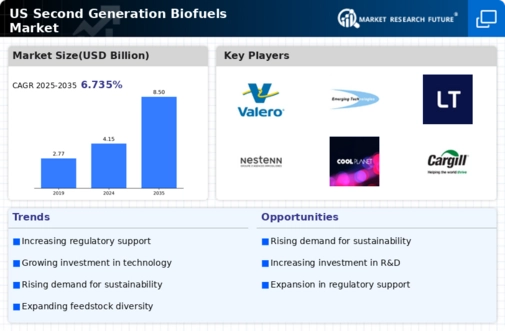The US Second Generation Biofuels Market has been experiencing a significant transformation driven by environmental concerns, regulatory support, and technological advancements. This sector mainly focuses on biofuels derived from biomass sources such as agricultural residues, waste materials, and non-food crops, making it a more sustainable alternative to first-generation biofuels. The market is characterized by a diverse range of players, including established biofuel companies, innovative startups, research institutions, and energy producers, all aiming to capitalize on the growing demand for renewable energy solutions. Competition is intense, as companies strive to enhance their production techniques, reduce costs, and improve product efficiency.
The evolving regulatory framework in the United States further shapes the competitive landscape, fostering an environment where companies are pushed to innovate and adhere to sustainability standards. Ecovative Design is a key player in the US Second Generation Biofuels Market, recognized for its innovative approach to biofuel production using sustainable materials. The company specializes in the development of advanced biofuels and bioproducts derived from agricultural waste, which positions it favorably in an environmentally conscious landscape.
The strength of Ecovative Design lies in its commitment to sustainability and the utilization of mycelium-based technology, which enhances the efficiency of biofuel production while significantly reducing carbon footprints. This unique methodology not only aligns with the increasing demand for cleaner energy solutions but also appeals to various stakeholders looking to invest in green technologies. With a strong research and development backbone, the company is well-positioned to expand its market presence and capitalize on the expanding interest in second-generation biofuels.
Infinity BioEnergy has carved out a niche within the US Second Generation Biofuels Market, focusing on the conversion of organic waste into high-quality biofuels. The company’s key products encompass biodiesel and ethanol produced from non-food agricultural feedstocks, which significantly alleviates the concerns associated with food-based biofuel production. Infinity BioEnergy’s strengths lie in its proprietary technology and extensive experience in the field, allowing it to streamline production processes and reduce operational costs. The company has been proactive in pursuing strategic mergers and acquisitions to bolster its capabilities and market reach, enhancing its competitive edge in the renewable energy landscape.
With an established presence, Infinity BioEnergy continues to lead the initiative toward sustainable energy solutions in the US, aligning its business model with the growing regulatory and consumer shift towards environmentally friendly alternatives.





















Leave a Comment